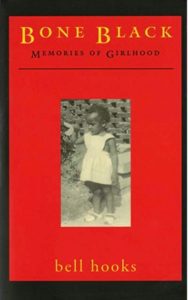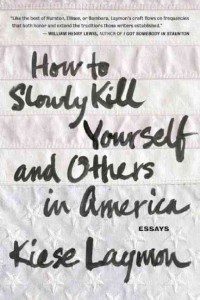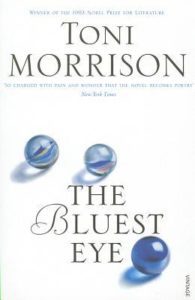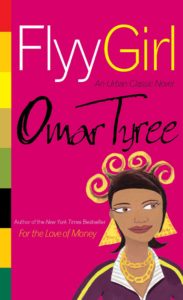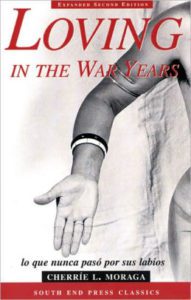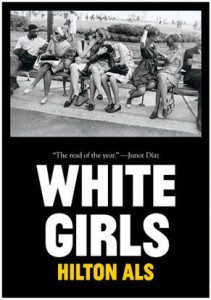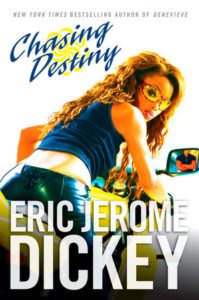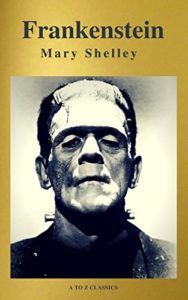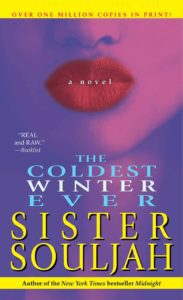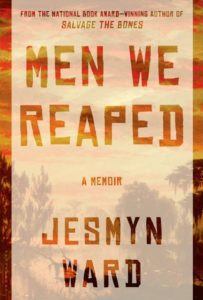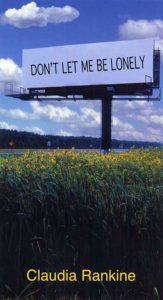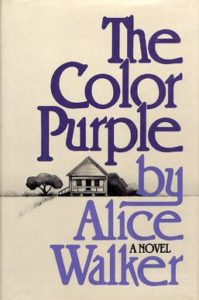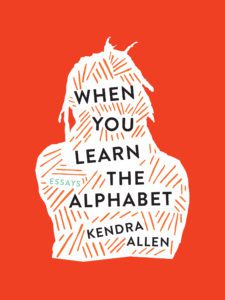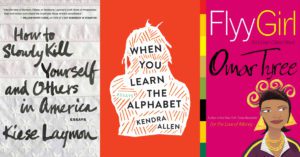
Two facts about growing up are forgiving your child self and picking out outfits everyday. I’m good at neither of these things—which is why When You Learn the Alphabet is what it is.
I essentially wrote all of it between the ages of nineteen and twenty-two—years when I had everything to say but knew nothing. I never felt like an adult, I only felt afraid. I describe When You Learn the Alphabet as a bunch of mad stories because once I began taking writing seriously, everything I didn’t realize I was angry about started to reveal itself in abundance. I thought I was simply completing assignments, but, surprisingly, I was crafting an essay collection.
I was (am) in a constant frenzy of having feelings about everything, remembering, unlearning, and reinterpreting. I was (am) looking for any way to express every wrong I felt happened to my bloodline and/or to me, and get it out of my body for good. I’ve failed tremendously along the way, but in taking on this task I learned that sometimes you wrong yourself the most. but the books listed below gave me solace.
Through these writers, I learned how to disguise my anger with sadness, to amplify my anger with politics, to suppress my anger with humor, and to simply experience my anger and live it. I’ve found myself constantly revisiting these books, hoping to cultivate a way to present my thoughts. Some of these books were introduced to me more recently, and others were found through decades of hiding behind books in order to avoid myself. I’ve chosen these books because of how well they get to their roots, and because I could feel the angry child in all of them.
***
Bone Black: Memories of Girlhood by bell hooks
Few things make me happier than books that aren’t afraid to get to the point sooner rather than later, and bell hooks ain’t a beat around the bush kind of writer. This is the book that taught me that telling the truth don’t take that long. I read Bone Black my second year of undergrad and felt an immense jealously that I could never be so plain yet so powerful, especially in memoir. This book is the exact book I dream of writing someday. It changed all of my expectations of what story is, and could be, making me comfortable with simply moving on once I had nothing more to say. There’s not a chapter in Bone Black that is more than three pages. There’s not a chapter in Bone Black that’s not doing tremendous work for black folk and little black girls. There’s not a chapter in Bone Black that doesn’t take the air out of your windpipe.
How to Slowly Kill Yourself and Others in America by Kiese Laymon
I didn’t have a favorite book until I read this one. How to Slowly Kill Yourself and Others in America was the first essay collection I read and it changed everything I previously thought about writing essays, and of what “personal essay” even meant. This is one of the most marked-up, most re-read, and most honest books I own. I had never encountered a writer who spoke how I spoke without their language being guarded and redirected, which was a big thing for me. And if we talking ’bout craft, Laymon found a way to make himself a border to protect the content; he found a way to make his content a conversation, and to make the essay cause the reader to question how they subscribe to America’s fabricated narratives. Endless gems. Endless laughs. Endless relatability. This was the first book to make me feel comfortable enough to use my own voice—no matter how grammatically incorrect it is, no matter its interests, no matter how passionate it can get—and to stand up in whatever I wrote on the page.
The Bluest Eye by Toni Morrison
I don’t know how I can think about style, or writing, period, without thinking of Toni Morrison and the endless times she’s demonstrated the multitudes of ways to tell a little black girl’s story. The Bluest Eye is the perfect example. Being that it’s Morrison’s debut novel, the way she tackled the hard truths of Pecola’s particular girlhood through the secondary characters not only exemplifies that she’s on an entirely differently level when it comes to skill, but also that she’s on a different level when it comes to evoking a image and a feeling that ties you to every character in this book. It’s a timeless piece of work and a master class on craft and story. I love you, Ms. Morrison. Please marry me.
Flyy Girl by Omar Tyree
I’m obsessed with coming-of-age stories no matter what medium they’re presented in. Flyy Girl was one of the first to come into my life. I remember being a child and all of the older, teenaged girls reading it while simultaneously living it. The book’s protagonist Tracy Ellison was the quintessential black girl. She was my best friend. She was my cousin. Some parts of her were even me. I thought Tracy was so fly and so flawed and I saw pieces of her in every girl around me. Omar Tyree made her real and a reflection. He mapped out her mental, physical, sexual, and emotional journey from the ages of six years old through twenty with style, grace, fun, pain, and most importantly, dialogue that felt like home. Every time I revisit Flyy Girl, it’s like I’m catching up to Tracy a little bit more than I previously had.
Loving in the War Years by Cherrie Moraga
There are certain songs that have the ability to transport you to a specific time and place. Fortunately, there are books that trigger past lives as well. Loving in the War Years is one of few that do this for me. Words like “wow” cannot do it justice. What a woman. What a talent. The fear in the language, the fearlessness in the language, the loud activism—it’s suffocating and all-consuming. Loving in the War Years is genre-bending, multilayered, multiethnic brilliance. Moraga is doing something I didn’t know was possible: to make one thing everything only for it to be named a collage when in fact it is a life. Easily the most beautiful, infuriating, loving, and loveless book I’ve ever read and I’m so thankful to have found it.
White Girls by Hilton Als
This book, although amazing in its entirety, is on this list for one essay alone. The first essay in this collection, “Tristes Tropiques,” is probably the greatest essay I’ve ever read. First, it’s eighty-four pages. I love the balance of seamlessly blending the personal with the cultural. I love all the questions. I love all the lyricism. I damn near am in love with Als himself. If we’ve ever had a conversation about nonfiction, I’ve more than likely mentioned “Tristes Tropiques” and pronounced it incorrectly. Every sentence feels like a privilege to read. Something I love about this essay, and this book for that matter, is I often feel like I’m not smart enough to read Als. Actually, I know I’m not smart enough to read him, but here, every line is doing the work to make me understand him. Just read this: “No one seemed to understand what we were talking about most of the time. There was no context for them to understand us, other than their fear and incomprehension in the presence of two colored men who were together and not lovers, not bums, not mad.” And Als doesn’t stray from providing the context, in a way that feels like a kiss goodbye.
Chasing Destiny by Eric Jerome Dickey
I have a deep, deep, love for black ass fiction that doesn’t care about being too black or too niche. Chasing Destiny was one of the books I found on my mama’s bookshelf when I was about twelve. I had no business reading it. It’s too much sex, too much violence, too much trauma, too many drugs, too many mistakes. But I was hooked, because “too much” was just a reality. I read it over and over again. Each time, I could not wait to see what happened to all of the characters. There was not a moment that dragged on too long. It was exciting, and I quickly learned excitement is an imperative element in any reading experience no matter how daring a book’s concept is perceived to be. I’ll never understand why the masses refuse to take these “urban fictions” seriously, and are instead satisfied with being bored to death by books and calling them classics, but I digress.
Frankenstein by Mary Shelley
Speaking of classics, if I let my English teacher from twelfth grade tell it, I didn’t know how to read at all until she taught me how to read Frankenstein. This was the first book I had to take line-by-line notes on, and I book I’ll probably never read again because of this. But, in hindsight, I found deeper meaning in a monster; I found that monsters aren’t always the villain; and I found that authorial intention, and watching that vision unfold, can coexist while also being entertaining. I guess I should say thank you to that teacher for helping me search for an author’s intentions just as much as I search for a story’s meaning. Shoutout to Ms. Rob.
The Coldest Winter Ever by Sister Souljah
All I’m gonna say is, The Coldest Winter Ever is my classic American novel and we gotta stop disrespecting Sister Souljah’s pen in these streets. The Coldest Winter Ever should never leave the best-seller’s list, if we’re being completely honest. Your favorite author couldn’t even fathom creating a Winter or a Midnight or a Natalie or a Bullet and making them human. Humanity isn’t even a word that would cross their minds. I’m still waiting for it to be adapted into a movie. Please let me cast it, or write it, or just be in the room while it’s made.
Men We Reaped by Jesmyn Ward
I lucked out on finding this book because Jesmyn Ward’s reputation precedes her. I’d never read any of her fiction, but during a workshop someone mentioned Men We Reaped and said they’d read it in a day. When I got my hands on a copy, it took me longer than a day to read it, but that’s because I was too in awe of the time, intention, and discipline it must have took to write through this concept and not stray away from it. I was too busy taking in every line, too busy trying to keep these men—these boys—alive as long as I could. I didn’t want any of their stories to end. Out of the thousands of books I’ve read in my lifetime, Men We Reaped was the first book that ever made me cry.
Don’t Let Me Be Lonely by Claudia Rankine
With most of Rankine’s work, the general consensus is: What is this? The first time I asked this was when I read Don’t Let Me Be Lonely. There’s pictures. There’s poems that could be essays that could also be stories. It’s unidentifiable, but it’s so striking you can’t help but participate in trying to figure it out. I admire Rankine’s lack of explanation. I’m envious of how freeing that must feel for her as a writer. I want to stop over-explaining, and Don’t Let Me Be Lonely helped to me realize it. Also, I’m not into naming things but I’m obsessed with titles, and Don’t Let Me Be Lonely is pure fire.
The Color Purple by Alice Walker
Form can take a book from mediocre to innovative. The Color Purple is everything but mediocre, and Walker’s choice to tell this story through letters only amplifies her genius. I’m intrigued by the different ways we can write a chronological narrative and how to place the reader on a rollercoaster of emotions without exhausting them. When I come across books like The Color Purple, I have to admit that skill this flawless may be something that can’t be taught. Even with all the nuance and difficult content, The Color Purple is an easy and enjoyable read, and if any other writer attempted to do this, the bridge might be impossible to cross. If this book taught me anything, it taught me about the distribution of time and how to delegate it between your characters. And, it taught me to be loud.
Giovanni’s Room by James Baldwin
I adore Baldwin in any genre, but my favorite is fiction-writing Baldwin. I was introduced to his words, to his voice, later than any living thing should be. I’d never read someone who wrote exactly how they spoke. The long-winded sentences, the punctuation stacking, the pause that’s so present on and off the page. When I read Giavonni’s Room, I felt heartbroken by everything the book held in its less than two hundred pages. The things Baldwin does with time, with desire, with anger, are unmatched. Everything written feels like an uppercut to the chin. Take this dialogue between David’s parents, for instance:
“…all I want for David is that he grows up to be a man. And when I say a man, Ellen, I don’t mean a Sunday school teacher.”
“A man,” said Ellen, shortly, “is not the same thing as a bull. Good-night.”
I mean, there’s really nothing more to say; we’re all just somebody’s child.
And to close out this wonderful list, we just had to include Kendra’s debut essay collection, When You Learn the Alphabet, forthcoming April 15 from University of Iowa Press! – Ed.
When You Learn the Alphabet by Kendra Allen
Kendra Allen’s first collection of essays—at its core—is a bunch of mad stories about things she never learned to let go of. Unifying personal narrative and cultural commentary, this collection grapples with the lessons that have been stored between parent and daughter. These parental relationships expose the conditioning that subconsciously informed her ideas on social issues such as colorism, feminism, war-induced PTSD, homophobia, marriage, and “the n-word,” among other things. These dynamics strive for some semblance of accountability, and the essays within this collection are used as displays of deep unlearning and restoring—balancing trauma and humor, poetics and reality, forgiveness and resentment. When You Learn the Alphabet allots space for large moments of tenderness and empathy for all black bodies, but especially all black woman bodies—space for the underrepresented humanity and uncared for pain of black girls, and space to have the opportunity to be listened to in order to evolve past it.

